
Hunting Creek, Its Ecology and Health
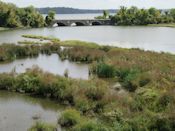
Dr. Kim de Mutsert, Assistant Professor, George Mason University (GMU), gave a presentation to the Friends of Dyke Marsh, the Potomac Riverkeeper and the Northern Virginia Conservation Trust on November 15, 2017, examining the health of Hunting Creek, a tributary of the Potomac River just north of Dyke Marsh. This stream receives treated wastewater from the Alexandria Renew Enterprises wastewater treatment plant and untreated stormwater runoff. Since 2013, Alexandria Renew has funded GMU’s Potomac Environmental Research and Education Center to monitor water quality and the biological communities of Hunting Creek.
Local Teachers Explore Learning Opportunities in Dyke Marsh
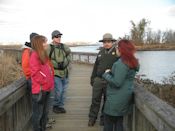
Three Mount Vernon High School teachers visited Dyke Marsh on November 19, 2017, doing “advance work” to prepare to bring MVHS environmental science and biology students to Dyke Marsh soon. Linda Townley, Victoria Correa and Amy Niss explored the flora, fauna and habitats of the preserve with NPS ranger Alex Parody, FODMers Ed Eder, Ned Stone and Glenda Booth, and discussed plans for students to visit and learn.
Saving Dyke Marsh’s Trees
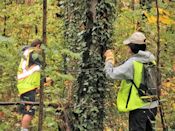
Fifteen enthusiastic volunteers helped rescue trees from invasive plants on a drizzly Sunday morning, November 5, 2017, working in the marsh along the bicycle path across from Tulane Drive. They tackled English ivy, porcelainberry, clematis/Virgin’s bower, honeysuckle and bittersweet, most of which can threaten the survival of many trees and shrubs. The trees and shrubs targeted included oaks, hollies, sassafrases, hornbeams, blackhaws, viburnums, spicebushes and strawberry bushes.
Volunteers Identify Butterflies and Dragonflies
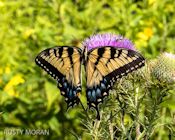
In the spring, summer and fall of 2017, a team of volunteers conducted regular surveys of Lepidoptera (butterflies, moths and skippers) and Odonata (dragonflies and damselflies) in the Dyke Marsh Wildlife Preserve. Here are a few examples of their sightings:
Good News on the Treated Pumpkin Ash Trees
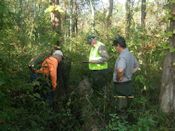
Since 2015, working with the National Park Service, FODM has been trying to save some of the pumpkin ash trees (Fraxinus profunda) of the marsh that are being attacked by the invasive, lethal insect, the emerald ash borer (Agrilus planipennis) (See our longer article in “Marsh Life”).
New Plant Observed in Dyke Marsh
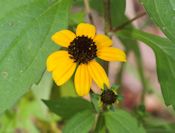
Several people observed brown-eyed Susans (Rudbeckia triloba) this summer, 2017, along the Haul Road. It appears to be a new species of Rudbeckia for Dyke Marsh and this is the first photographic record of the species on George Washington Memorial Parkway (GWMP) properties. The plant was last observed in GWMP in Great Falls Park in 1919.
Monarchs Migrate through Dyke Marsh in the Fall
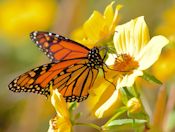
In the fall of 2017, the last generation of eastern monarch butterflies (Danaus plexippus) is migrating southwest to the mountains of central Mexico. Some of the butterflies are stopping to sip nectar from the masses of smooth beggartick blossoms blooming in Dyke Marsh.
Ridding the “Beltway Wetlands” of Trash

On September 23, 2017, FODMers joined Northern Virginia Conservation Trust (NVCT) and Porto Vecchio volunteers on a kayak and canoe trash cleanup of NVCT’s newest property, a two-acre wetland at the confluence of Cameron Run and Hunting Creek on Alexandria’s southern border, just north of Dyke Marsh. The tidal wetlands, under the Beltway/I-95 ramps and elevated highways, are favorite sites for roosting gulls, migrating shorebirds and other birds, especially at low tide, an eBird “hotspot.”
The Potomac River’s Submerged Aquatic Vegetation
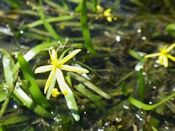
FODMers and friends learned about the importance, abundance and distribution of submerged aquatic vegetation (SAV) in the Potomac River on September 13, 2017, when Dr. Nancy Rybicki, U.S. Geological Survey aquatic plant biologist and hydrologist, spoke to 55 attendees.
The FODM Fall Walk, Plants and More
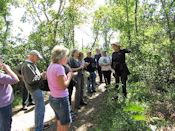
On a walk that FODM announced as a “plant walk,” 25 Dyke Marsh enthusiasts enjoyed the flora, fauna and more on a balmy September 9, 2017, in Dyke Marsh. Retired George Washington University botany professor Elizabeth Wells led the group along the Haul Road trail out to the boardwalk for almost three hours. Ms. Wells depth of knowledge and the rich biodiversity of the marsh easily held everyone’s attention.
Why That Bare Area? Tackling Invasive Plants
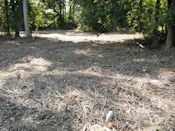
Many visitors to Dyke Marsh who walk along the Haul Road trail have questions about the cleared area on the west side of the trail across from “Dead Beaver Beach.”The answer: The National Park Service and FODM are creating a demonstration plat, clearing the area of a massive invasive plant infestation and eventually planting some native plants.
Cardinal Flowers Brighten the Marsh
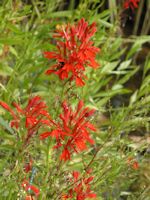
The bright, scarlet cardinal flowers (Lobelia cardinalis) blooming in Dyke Marsh in August and September 2017 are delighting many visitors, including migrating hummingbirds. “The tube-shaped flowers have two lips, the upper having two lobes and the lower lip so fragile, many insects cannot land on the plant to reach the nectar,” according to the guidebook, Walking the Wetlands.


AlbertHerring-b4cc6b5cfb.jpg)



 Friends of Dyke Marsh, Inc. is a non-profit 501(c)(3) organization.
Friends of Dyke Marsh, Inc. is a non-profit 501(c)(3) organization.